Sentence Structure Teaching Resources
Teach students the elements of sentence structure this school year with printable worksheets, sentence-building activities, sorting games and more elementary school teaching resources designed to help extend your students' understanding of how to write clear and concise sentences that follow the rules of English grammar.
This extensive collection of teaching resources has been created by teachers for teachers like you. Aligned to the Common Core curriculum, the ELA collection includes editable worksheets and teaching presentations and more to save elementary teachers time on lesson planning.
Created by expert teachers, each resource in this sentence collection has been carefully reviewed and curated by our team. That means it's ready to use in the classroom! You'll even find editable resources, plus differentiated options.
New to teaching about sentence structure, or just looking for fresh ways to engage your students? Read on for a primer from our teaching team!
English Sentence Structure Explained
From subjects to predicates, objects to clauses, the English language is packed with rules specific to sentence structure that students need to learn on the way to becoming proficient writers.
Ready to break down how to build a sentence in English and look at some examples? Let's go!
Subject
The subject of a sentence is the noun or pronoun that performs the action or is described in the sentence.
For example, in the sentence "Jaquan did his homework," Jaquan is the subject.
Predicate
The predicate of a sentence expresses the action or state of being in a sentence.
Let's go back to the sentence "Jaquan did his homework." In this case, did is the predicate.
Object
The object of a sentence is a noun or pronoun that receives the action of the verb.
For example, "homework" would be the object in "Jaquan did his homework."
Complement
The complement of a sentence is a word or phrase that completes the meaning of a sentence.
The complement can be a direct object, indirect object, or subject complement.
For example: "a doctor" in "She became a doctor."
Modifier
A modifier in a sentence provides additional information about a word or phrase in the sentence. It can be an adjective or an adverb. Example: "kind" in "She was a kind teacher."
What Are Clauses?
Clauses are groups of words containing a subject and a verb. They're important to understand when learning sentence structure. After all, one kind of clause is a sentence!
There are two main types of clauses:
- Independent Clause — An independent clause can stand alone as a complete sentence because it expresses a complete thought. For example: "I did all of my homework."
- Dependent Clause — A dependent clause cannot stand alone as a sentence because it does not express a complete thought. It relies on an independent clause to make sense. Example: "When I went to the store," (Dependent clause) "I bought an apple." (Independent clause). Dependent clauses can be paired with independent clauses to build sentences.
- Plus Plan

5 Star Writing Poster and Bookmark Set
Share this 5 star writing poster and bookmark set with your students to remind them how to be "star" writers!
- Plus Plan
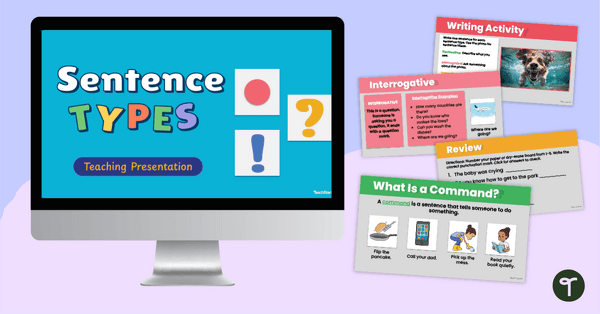
Statement, Question, Command & Exclamation Sentences Teaching Slides
Introduce statement, command, question, and exclamation sentences with an interactive teaching slide deck.
- Plus Plan

Stretchy Sentences Worksheet
Use this worksheet to help your students write detailed and descriptive sentences.
- Plus Plan

Trace, Draw and Order Sentences Worksheets
Use this set of sentence cut-and-paste worksheets to help your students build simple sentences.
- Plus Plan

Independent and Dependent Clauses - Worksheet Pack
Introduce the concept of independent and dependent clauses with a set of printable sentence structure worksheets.
- Plus Plan
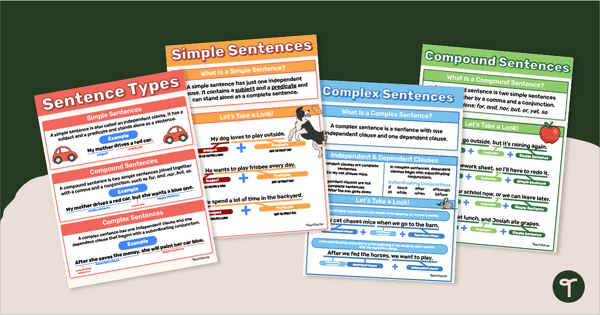
Simple, Compound, and Complex Sentences Poster Pack
Display and use these handy anchor charts to teach your students about simple, compound, and complex sentences.
- Plus Plan
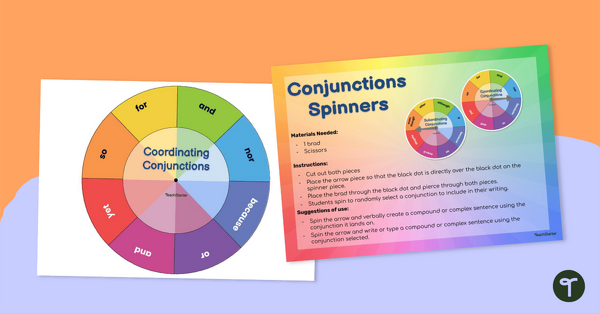
Conjunctions Spinners (Coordinating Conjunctions, Subordinating Conjunctions, Correlative Conjunctions)
Bring some fun to your grammar lessons with these colorful conjunctions spinners! Students spin to reveal a conjunction to use in their writing or oral language.
- Plus Plan

Simple, Compound and Complex Sentences Worksheets
Use this set of five grammar worksheets to teach about the structures of simple, compound and complex sentences.
- Plus Plan

Coordinating Conjunctions Dice Game
Use this hands on activity for students to create two 8 sided-dice and write compound sentences using coordinating conjunctions.
- Plus Plan

FANBOYS Poster for Teaching Coordinating Conjunctions
Display this grammar poster in your classroom to help students choose appropriate coordinating conjunctions using the acronym FANBOYS.
- Plus Plan

Easter Grammar - Worksheets
Practice grammar conventions with a pack of Easter English worksheets.
- Plus Plan

Cupid's Compound Sentences Valentine's Day Activity
Build some sweet sentence writing skills using a fun Valentine’s Day Compound Sentence interactive activity.
- Plus Plan

St. Patrick's Day Writing Prompt Worksheets
Celebrate St. Patrick’s Day and write imaginative stories using a collection of narrative writing prompts.
- Plus Plan

Valentine's Day - 3rd Grade English Worksheets
Review and practice a wide range of grammar skills with a pack of printable 3rd grade writing worksheets.
- Plus Plan

Holiday Worksheet - Easter Sentences
Build and write sentences about Easter sentence-building worksheets.
- Plus Plan

Daily Grammar - Sentence Structure Warm-Ups – Grades 3 and 4
An engaging 40-slide interactive Google Slides deck to use in grades 3 and 4 when learning about grammar and sentence structure.
- Plus Plan

Holiday Worksheet - Groundhog Day
Build and write sentences about Groundhog Day with a no-prep Groundhog Day worksheet.
- Plus Plan

Springtime Sentence Building - Interactive Activity
Build a strong sentence-writing foundation with an interactive spring sentence-building activity.
- Plus Plan

Write About It! Spring Sentence Writing Worksheets
Introduce new writers to writing complete sentences in early grades with a group of kindergarten writing prompts about spring.
- Plus Plan

Write About It! Winter Sentence Builder Pack
Differentiate writing instruction in primary grades with a group of leveled informational writing prompts about winter
- Plus Plan

United States Patriotic Symbols - Holiday Worksheets
Build and write sentences about patriotic holidays in the United States with a group of six holiday sentence-building worksheets.
- Plus Plan

Write About It! Halloween Costumes
Differentiate writing instruction in primary grades with a group of leveled Halloween writing prompts about Halloween costumes.
- Plus Plan

Halloween Writing Prompts - Bats
Differentiate writing instruction in primary grades with a group of leveled Halloween writing prompts about bats.
- Plus Plan

Write About It! Spiders
Differentiate writing instruction in primary grades with a group of leveled informational writing prompts about spiders
- Plus Plan

Earth Day Build a Sentence Worksheet
Build and write sentences about Earth Day with a cut-and-paste Earth Day worksheet for kindergarten and first grade.
- Plus Plan

Patriotic Holiday Worksheets – Sentence Building
Build and write sentences about different patriotic holidays with this cut-and-paste worksheet
- Plus Plan

Valentine's Day Worksheet - Sentence Building
Build and write sentences about Valentine's Day with a cut-and-paste Valentine's Day worksheet for kindergarten and first grade.
- Plus Plan

Subject Verb Agreement (Irregular Verbs) Digital Activity
Teach subject-verb agreement of irregular verbs with this engaging digital activity, where students will master tricky pairs like was/were, is/are, has/have and do/does.
- Plus Plan
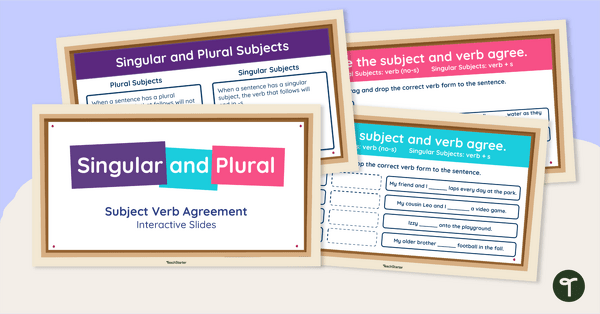
Singular and Plural Subject Verb Agreement – Interactive Activity
Teach singular and plural subject-verb agreement with this interactive drag-and-drop resource, designed to help students master correct verb usage in a fun and engaging way.
- Plus Plan

Identifying Dependent Clauses Worksheet
Practice identifying dependent clauses in complex sentences with a dependent clause worksheet.
- Plus Plan
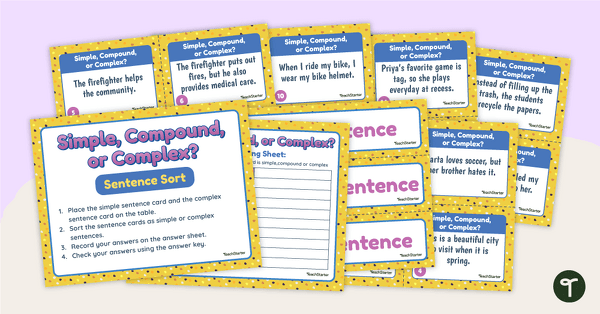
Simple, Compound, and Complex Sentences Sort
Practice reading, identifying, and writing simple, compound, and complex sentences with a sorting activity.
- Plus Plan

Has or Have? Subject Verb Agreement Task Cards
Download these has or have task cards, designed to help students confidently choose the correct verb form while improving their grammar skills.
- Sentence Structure Worksheets
- Sentence Structure Games
- Sentence Structure Templates
- Sentence Structure Posters
- Sentence Structure for Kindergarten
- Sentence Structure for 1st Grade
- Sentence Structure for 2nd Grade
- Sentence Structure for 3rd Grade
- Sentence Structure for 4th Grade
- Sentence Structure for 5th Grade
- Sentence Structure for 6th Grade